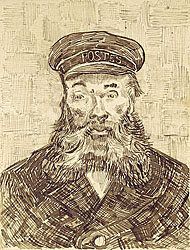 |
 |
 |
 |
Grades/Level: Middle School (6–8)
Subjects: Visual Arts
Time Required: 2–Part Lesson
One to two class periods
Author: J. Paul Getty Museum Education Staff
Permissions: 
The lesson plan and downloadable materials on this page are licensed under a Creative Commons Attribution 4.0 International License. |
 |
|
 |
 |
 |
 |
 |
 |
 |
Lesson Overview |
 |
Students will use Van Gogh's Portrait of Joseph Roulin as inspiration for their own portraits of friends in the classroom. |
 |
 |
 |
 |
 |
Learning Objectives |
 |
Students should be able to:
• learn about portraits.
• analyze Van Gogh's use of line in his Portrait of Joseph Roulin.
• learn the technique of hatching and cross-hatching.
• use the art element of line, along with the techniques of hatching and cross-hatching, to execute a portrait. |
 |
 |
 |
 |
 |
 |
 |
 |
 |
Materials |
 |
• Reproduction of Portrait of Joseph Roulin by Vincent van Gogh
• Drawing paper
• Ink pens
• Reed pens
• India ink |
 |
 |
 |
 |
 |
|
|
 |
 |
 |
 |
 |
Lesson Steps |
 |
1. Begin by using the Questions for Teaching for Portrait of Joseph Roulin
by Vincent van Gogh. Both are found in the Image Bank, or by clicking on the thumbnail of the image above.
2. Focus the discussion on the techniques Van Gogh used to create this portrait. Look at
the questions that examine the types of line used in the portrait. Focus on how he creates contrast and shade using both hatching and cross-hatching.
3. Explain to students that they are going to create portraits of friends using the techniques that Van Gogh used in his portrait of Joseph Roulin.
4. Explain facial proportions:
• The eyes are halfway between the top of the head and the chin.
• The bottom of the nose is halfway between the eyes and the chin.
• The mouth is halfway between the nose and the chin.
• The corners of the mouth line up with the centers of the eyes.
• The tops of the ears line up above the eyebrows.
• The bottoms of the ears line up with the bottom of the nose.
5. Demonstrate the technique of hatching and cross-hatching to create shade and shadow and define forms. Students will also be asked to include a variety of line work in their finished portrait. Have students practice using hatching and cross-hatching on three-dimensional forms like the cube, pyramid, and sphere.
5. For their portrait, students will choose a friend as their subject, just as Van Gogh chose to draw and paint his friend Roulin. Students should take turns drawing each other, possibly allowing about one class period for each drawing.
6. Students will work on their drawings using ink pens or reed pens. They may begin by setting up their proportions using pencil for preliminary work. Shading and hatching should be done with the ink pen or reed pen.
7. Hold a class critique of their portraits. Discuss the challenges and successes of working with the hatching technique and with getting the facial proportions worked out. |
 |
 |
 |
| Portrait of Joseph Roulin, Vincent van Gogh, 1888
|
 |
|
 |
 |
 |
 |
 |
 |
 |
Assessment |
 |
Students will be assessed based on their use and understanding of the facial proportions, hatching and cross-hatching techniques, and the variety of line work used in their portrait. |
 |
 |
 |
 |
 |
Extensions |
 |
Research other portraits of Joseph Roulin by Vincent van Gogh.
• How does his treatment of the same subject change in different media?
• Why do you think he painted the same portrait repeatedly?
• How do the portraits of Roulin change over time?
• Van Gogh not only painted Joseph Roulin repeatedly but he also painted Roulin's entire family many times. Why do you think Van Gogh was interested in painting an entire family?
(You can find other Van Gogh portraits of Joseph Roulin in the following institutions: Detroit Institute of Arts; Museum of Fine Arts, Boston; and the Museum of Modern Art.) |
 |
 |
 |
 |
 |
 |
 |
 |
 |
Standards Addressed |
 |
Common Core Standards for English Language Arts
Grades 6–8
WRITING
Research to Build and Present Knowledge
7. Conduct short as well as more sustained research projects based on focused questions, demonstrating understanding of the subject under investigation.
8. Gather relevant information from multiple print and digital sources, assess the credibility and accuracy of each source, and integrate the information while avoiding plagiarism.
SPEAKING AND LISTENING
Comprehension and Collaboration
1. Prepare for and participate effectively in a range of conversations and collaborations with diverse partners, building on others' ideas and expressing their own clearly and persuasively.
2. Integrate and evaluate information presented in diverse media and formats, including visually, quantitatively, and orally.
Visual Arts Content Standards for California Public Schools
1.1 Identify and describe all the elements of art found in selected works of art (color, shape/form, line, texture, space, and value).
1.3 Describe how artists can show the same theme by using different media and styles.
2.4 Create increasingly complex original works of art reflecting personal choices and increased technical skill.
2.5 Select specific media and processes to express moods, feelings, themes, or ideas. |
 |

|
 |
 |
 |


